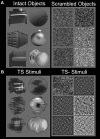Smooth versus Textured Surfaces: Feature-Based Category Selectivity in Human Visual Cortex
- PMID: 27699206
- PMCID: PMC5035775
- DOI: 10.1523/ENEURO.0051-16.2016
Smooth versus Textured Surfaces: Feature-Based Category Selectivity in Human Visual Cortex
Abstract
In fMRI studies, human lateral occipital (LO) cortex is thought to respond selectively to images of objects, compared with nonobjects. However, it remains unresolved whether all objects evoke equivalent levels of activity in LO, and, if not, which image features produce stronger activation. Here, we used an unbiased parametric texture model to predict preferred versus nonpreferred stimuli in LO. Observation and psychophysical results showed that predicted preferred stimuli (both objects and nonobjects) had smooth (rather than textured) surfaces. These predictions were confirmed using fMRI, for objects and nonobjects. Similar preferences were also found in the fusiform face area (FFA). Consistent with this: (1) FFA and LO responded more strongly to nonfreckled (smooth) faces, compared with otherwise identical freckled (textured) faces; and (2) strong functional connections were found between LO and FFA. Thus, LO and FFA may be part of an information-processing stream distinguished by feature-based category selectivity (smooth > textured).
Keywords: FFA; LO; fMRI; functional connectivity; texture.
Figures











References
-
- Aguirre GK, Detre JA, Alsop DC, D'Esposito M (1996) The parahippocampus subserves topographical learning in man. Cereb Cortex 6:823–829. - PubMed
-
- Albright TD (1984) Direction and orientation selectivity of neurons in visual area MT of the macaque. J Neurophysiol 52:1106–1130. - PubMed
-
- Brainard DH (1997) The psychophysics toolbox. Spat Vis 10:433–436. - PubMed
MeSH terms
Grants and funding
LinkOut - more resources
Full Text Sources
Other Literature Sources
